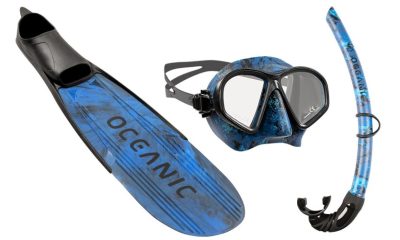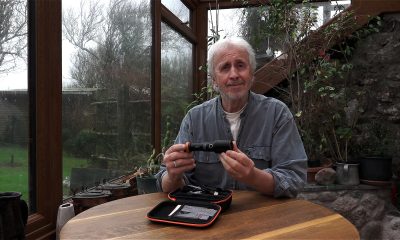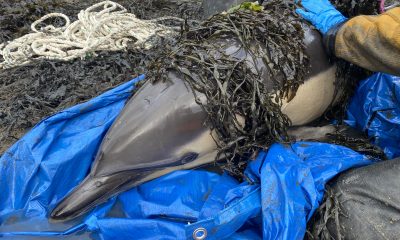News
A seagull and an unforgiving sea

It was a bright winter morning on the cliff tops near Sennen Cove in Cornwall. The dark clouds had rolled away leaving a bright sun and a brisk wind. The sea was a clear blue with cresting white water on the wave tops crashing onto the shallow shoreline below.
The Gulls were wheeling high above as well as skimming the cliff face with all the grace and skill of any flying bird. Simply gliding they would race along the rocky edges before turning away to be taken by the updrafts into the clear sky. Others held station a few feet from the cliff tops as if supported by an invisible hand. The shear aviation ability and skill of these birds is truly remarkable. They were calling loudly to one another. What they were saying I have no idea. Maybe they were just calling with sheer pleasure.
Seagulls are too often maligned for being a nuisance; stealing our chips, making too much noise, messing on our cars, etc. But perhaps we should give a moment to consider where the fault actually lies. We have taken much of their habitat, we have destroyed much of their food, we have polluted their environment. Then we take great delight in feeding them when it pleases us, only to complain when they gather around our takeaway pasties.
I think it is in fact remarkable how seagulls have adapted to the modern day world. It has always amazed me when out on a diving boat how one single bird will track and keep an eye on us no matter how far out to sea we go. Then if there is even a slight hint of a free meal, within minutes where there was one there may now be ten or twenty. How do they do that?
Below me at the base of the cliffs a large swell was crashing on the foreshore. Thirty or forty gulls were swimming on the turbulent water looking for food. As each wave approached, the birds easily lifted into the air to let the foaming water pass before once again they settled back down to their foraging. Their timing was impeccable. Then as I watch a juvenile got it completely wrong and got caught by a large wave. The gull was taken under the water and disappeared. I heard myself say ‘Oh no’. Then the bird resurfaced, but it was now well inshore of the breaking surf. I could see it was in shock and panic as it tried to swim its water soaked body out into deeper water. Another wave hit it and once again the young bird disappeared only to resurface even nearer to the shore. It was too waterlogged now to try flying and was desperately swimming out towards the other gulls that seemed quite oblivious to its peril. Even if they were aware there was nothing they could do. Juvenile birds are watched over by adult males and will stay in the flock until old enough to breed, but this bird was very much alone.
Another wave hit it and almost took it into shore. I was calling out to it. ‘Go ashore…. the other way… go to the beach….’ but in its blind panic, even though only a few meters from the safety of the pebble beach, the bird continued its struggle out to sea. Again the gull was taken under the water by a large wave and this time it did not resurface.
I sat and watched in silence and with great sadness as the sea continued throwing its waves on the beach and gulls only fifty meters or so out continued their search for food. I felt quite helpless.
I am always sad when I see an animal die, especially if it is unnecessary. In reality animals die in the wild all the time; we just hardly ever get to see it happen. In the great scheme of things nothing was really lost at the passing of the bird. It was a personal tragedy for it alone. The inexperience of life, the fear, the panic, the pain of drowning.
As divers, we all face the sea on a regular basis and often become complacent to its unforgiving power and indifference. Yet the sea is truly a huge and powerful living organism, sustaining life as well as taking it. Next time you are in its company, have a thought for the gull and consider the untold struggles for life the oceans witness every day.
Gear News
Scubapro Free Octopus Promotion 2024

Free Octopus with every purchase of a SCUBAPRO regulator system
Just in time for the spring season, divers can save money with the FREE OCTOPUS SPRING PROMOTION! Until July 31st SCUBAPRO offers an Octopus for free
with every purchase of a regulator system!
Get a free S270 OCTOPUS with purchase of these combinations:
MK25 EVO or MK19 EVO with A700
MK25 EVO or MK19 EVO with S620Ti
MK25 EVO or MK19 EVO with D420
MK25 EVO Din mit S620Ti-X
Get a free R105 OCTOPUS with purchase of the following combinations:
MK25 EVO or MK19 EVO with G260
MK25 EVO or MK17 EVO with S600
SCUBAPRO offers a 30-year first owner warranty on all regulators, with a revision period of two years or 100 dives. All SCUBAPRO regulators are of course certified according to the new European test standard EN250-2014.
Available at participating SCUBAPRO dealers. Promotion may not be available in all regions. Find an authorized SCUBAPRO Dealer at scubapro.com.
More information available on www.scubapro.com.
Blogs
Northern Red Sea Reefs and Wrecks Trip Report, Part 3: The Mighty Thistlegorm

Jake Davies boards Ghazala Explorer for an unforgettable Red Sea diving experience…
Overnight, the wind picked up, making the planned morning dive a bit bumpy on the Zodiacs to the drop point on Thomas Reef. There, we would dive along the reef before descending through the canyon and then passing under the arch before ascending the wall with a gentle drift. The site provided great encounters with more pelagic species, including shoals of large barracuda, tuna, and bigeye trevally.
Once back on the boat, it was time to get everything tied down again as we would head back south. This time, with the wind behind us, heading to Ras Mohammed to dive Jackfish Alley for another great gentle drift wall dive before then heading up the coast towards the Gulf of Suez to moor up at the wreck of the Thistlegorm. This being the highlight wreck dive of the trip and for many onboard, including myself, it was the first time diving this iconic wreck. I had heard so much about the wreck from friends, and globally, this is a must on any diver’s list. Fortunately for us, there was only one other boat at the site, which was a rarity. A great briefing was delivered by Ahmed, who provided a detailed background about the wreck’s history along with all the required safety information as the currents and visibility at the site can be variable.

Kitting up, there was a lot of excitement on deck before entering the water and heading down the shoreline. Descending to the wreck, there was a light northerly current which reduced the visibility, making it feel more like the conditions that can be found off the Welsh coast. At 10m from the bottom, the outline of the wreck appeared as we reached the area of the wreck which had been bombed, as our mooring line was attached to part of the propeller shaft. Arriving on deck, instantly everywhere you looked there were many of the supplies which the ship was carrying, including Bren Carrier tanks and projectiles that instantly stood out.

We headed around the exterior, taking a look at the large propeller and guns mounted on deck before entering the wreck on the port side to take a look in the holds. It was incredible to see all the trucks, Norton 16H, and BSA motorcycles still perfectly stacked within, providing a real snapshot in time.

Overall, we had four dives on the Thistlegorm, where for all of the dives we were the only group in the water, and at times, there were just three of us on the whole wreck, which made it even more special, especially knowing that most days the wreck has hundreds of divers. Along with the history of the wreck, there was plenty of marine life on the wreck and around, from big green turtles to batfish, along with shoals of mackerel being hunted by trevally. Some unforgettable dives.

The final leg of the trip saw us cross back over the Suez Canal to the Gobal Islands where we planned to stay the night and do three dives at the Dolphin House for the potential of sharing the dive with dolphins. The site, which included a channel that was teeming with reef fish, especially large numbers of goatfish that swam in large shoals along the edge of the reef. These were nice relaxing dives to end the week. Unfortunately, the dolphins didn’t show up, which was okay as like all marine life they are difficult to predict and you can’t guarantee what’s going to be seen. With the last dive complete, we headed back to port for the final night where it was time to clean all the kit and pack before the departure flight the next day.

The whole week from start to finish on Ghazala Explorer was amazing; the boat had all the facilities you need for a comfortable week aboard. The crew were always there to help throughout the day and the chefs providing top quality food which was required after every dive. The itinerary providing some of the best diving with a nice mixture of wreck and reef dives. I would recommend the trip to anyone, whether it’s your first Red Sea liveaboard in the Red Sea or you’re revisiting. Hopefully, it’s not too long before I head back to explore more of the Red Sea onboard Ghazala Explorer.

To find out more about the Northern Red Sea reef and wrecks itineraries aboard Ghazala Explorer, or to book, contact Scuba Travel now:
Email: dive@scubatravel.com
Tel: +44 (0)1483 411590
Photos: Jake Davies / Avalon.Red
-

 News3 months ago
News3 months agoHone your underwater photography skills with Alphamarine Photography at Red Sea Diving Safari in March
-

 News3 months ago
News3 months agoCapturing Critters in Lembeh Underwater Photography Workshop 2024: Event Roundup
-

 Marine Life & Conservation Blogs2 months ago
Marine Life & Conservation Blogs2 months agoCreature Feature: Swell Sharks
-

 Blogs2 months ago
Blogs2 months agoMurex Resorts: Passport to Paradise!
-

 Blogs2 months ago
Blogs2 months agoDiver Discovering Whale Skeletons Beneath Ice Judged World’s Best Underwater Photograph
-

 Gear Reviews3 months ago
Gear Reviews3 months agoGear Review: Oceanic+ Dive Housing for iPhone
-

 Marine Life & Conservation2 months ago
Marine Life & Conservation2 months agoSave the Manatee Club launches brand new webcams at Silver Springs State Park, Florida
-

 News3 months ago
News3 months agoWorld’s Best Underwater Photographers Unveil Breathtaking Images at World Shootout 2023
















